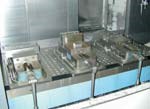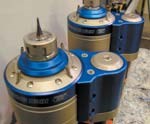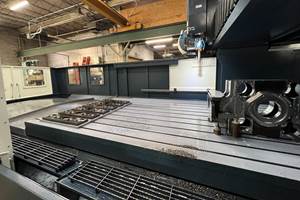Cutting Time
This company modified its production process to cut not just metal, but also setup time, costs and the effects of the labor crunch.
Share





Leggett & Platt Machine Products (Carthage, Missouri) is a division of Leggett & Platt, Inc., a $4 billion Fortune 500 company and the world's largest manufacturer of bedding components. The machines made at this 100,000-square-foot machine shop manufacture coil springs, innerspring units and welded grids for a number of its parent company's branches around the world.
Growth at Machine Products has been steady over the years—its facility plans to expand by an additional 100,000 square feet this year—and it currently has about 225 employees producing more than 25,000 different components. This continued development points to the company's success evaluating and changing operations. To attract more jobs and to grow its business, several years ago Machine Products embarked on a self-assessment. Because even though the shop primarily makes machines for its parent company, Machine Products still has to compete with outside suppliers for L & P's work.
Today the company finds that it quotes jobs 30 to 60 percent cheaper than some of those suppliers. A major reason is the continuous improvement initiative the company began that resulted in a new setup procedure to cut changeover delay for jobs on the Mazak (Florence, Kentucky) CNC vertical machining centers. The only downtime Machine Products wants associated with its business is the time people spend lying on its mattresses.
Changing Process And People
For the machine operator using the new procedure, setup begins by checking the grease board that lists jobs already prepared by the presetter. The operator checks off the next job on the list and gets the corresponding push cart that contains all of the tooling needed to do the job.
Each cart holds a rack with all the tools and toolholders, soft jaws and other workholding needed, as well as the setup instructions and a program book to illustrate the part to be machined. This material has all been gathered together by the presetter before the operator is ready to run the job.
This process differs from the "old way," when operators began a job by finding tool dimensions using their own gages and spent a good deal of setup time finding and assembling the tool and toolholder and making sure the tool was sharp. All this took an estimated 7 to 12 minutes per tool, and more time was added as operators cut the soft jaws to fit the job.
Now, the presetter determines tool offsets and measurements before the machine operator begins a job. She gathers tooling and measures the tools on the company's Parlec (Fairport, New York) presetter, then she sends tool offsets to the DNC server so they will be pulled to the CNC along with the part program.
By centralizing all of these steps and taking them out of operators' hands, the company was able to reduce average setup time from 6.4 hours to 1.5 hours. Since Machine Products did about 3,200 setups per year on its eight VMCs, the company projected the resulting time savings to be more than 15,000 hours annually.
But this process only worked because the employees bought into it. If machine operators did not trust the work of the presetter, more time would be added to setup as they checked her work. The old system was inefficient, says Ron Robbins, director of manufacturing, but at first it was a challenge to get workers to abandon the way they always did it. There was a change in mindset necessary to implement this system where operators let go of certain tasks—such as pulling tools and fixturing together—and instead followed precise instructions. Adaptable, team-oriented employees were essential for realizing the productivity improvement. "No process is the best process," Mr. Robbins says. "You mesh ideals, thoughts and processes, and you throw out the worst and keep the best." He and four other co-workers made up the team responsible for evaluating and changing the old setup routine.
But altering the tool measurement and gathering process was not the only way the team recommended setup work be divided among specialists. The company also capitalized on the skills of three machinists who together account for more than 80 years of shop experience. Operators used to machine their own soft jaws for each job. Now these machinists do that work more efficiently.
So that machine operators can quickly set up the vises that hold these jaws, each VMC has a fixturing plate on its table consisting of a grid of tapped holes. The setup instructions for each job tell the machine operator where to locate the vise on the plate so the part program runs accurately, since each program is referenced from the same datum point on the plate. The position of this starting point is verified weekly on every machine, since the manufacture of precise parts depends on it.
This process has helped shorten setup time and reduce scrap rate. When the machine operator was setting up jobs the old way, the lost time "was killing us," says Derek Martin, Machine Products general manager. "Before, you would spend a shift setting a part up." Even today there is an ongoing effort to evaluate the process of setting up each job. At an average of 2.5 hours for changeover, the company still sees room for improvement.
The Inventory Issue
Cutting and limiting inventory was another goal in Machine Products' continuous improvement plan that aimed to devote fewer resources to storing and tracking inventory. The addition of a centralized tool crib, for example, cut down on shelving—a benefit that spoke to the company's problem of a lack of space. Mr. Martin now monitors just how little tool inventory he can get away with. Based on 6 months of data, he estimated that the company can turn this inventory 12 times per year.
Electronically tying the tool crib into the purchasing system has cut down on paperwork and improved efficiency with ordering and tracking. Before the centralized tool crib was created, different departments would submit handwritten orders for their own tools, and sometimes the tool vendor would be confused by similar orders from different departments. Also, since the addition of the tool crib, now the operators know tools will be in stock. The transition to the new system—and the employees' trust in it—resulted in the reduction of "invisible" inventory stored in operators' workspaces.
Long-Run Benefits
Making the best use of its resources means not only does Machine Products seek efficiency in its parts and pieces, but also in its personnel. "Because of the lack of skilled employees in the job market, we have had difficulty hiring for the ‘off' shifts," Mr. Martin says. As a result, the company intends to expand its vertical area less and instead move toward unattended operation on its horizontal machining centers. The company has been running two Mazak Palletech cells unattended on the third shift since late 2000.
The challenge this presents to an HMC operator is that he must set up jobs in advance of the shift change. "In particular, you have to strategize your tool use," Mr. Martin says. "You look for as many ways you can to use the same tool for multiple jobs you are setting up." One regret the shop has with these machines is that it didn't specify even more tool capacity when it bought them.
Probably the only reason more VMCs will be added is if special jobs require them.
The VMCs are still better at cutting parts in short runs, Mr. Robbins says, but the HMCs outshine them with a multitude of other benefits. "With the VMCs, you need one operator per machine per shift," he says. "With the HMC, you can run unattended sometimes or one operator per two machines other times. And the fact that the spindle doesn't have to be stopped to change over the job makes the horizontal on average 20 percent more efficient than the vertical running the same job, even when the VMC changeover process is really efficient," he says. Also, with smaller parts, HMCs offer the chance to run diversified batches in one setup because the company uses a multiple-face tombstone. Primarily because the HMCs are being set up the same time they are machining parts, Machine Products finds they are better used for rush jobs and long runs because there is no downtime during changeover. Unlike the VMCs, quick changeovers are not so pressing a concern on the horizontal cells because the machine is still cutting while changeover occurs.
For most work, the HMCs make more sense, Mr. Martin says. The ability to run jobs unattended is the key, in light of the challenge machine shops face finding skilled workers. A streamlined setup procedure on the vertical machining centers lets Machine Products make the best use of the employees it has, and an investment in cellular HMCs keeps the shop producing parts as employees become harder to find.
Related Content
Three-Axis Bridge Mill Opens New Doors for Construction OEM
Different industries often require different machining priorities, a truism recently demonstrated by Barbco, an OEM of heavy-duty boring equipment that opened up new design possibilities by pivoting toward rigid, less complex machining centers.
Read MoreHow a Custom ERP System Drives Automation in Large-Format Machining
Part of Major Tool’s 52,000 square-foot building expansion includes the installation of this new Waldrich Coburg Taurus 30 vertical machining center.
Read MoreMitsui Seiki's Compact VMC Offers High-Precision Milling
The VL30 series is designed to machines high-precision mold inserts for medical, packaging, industrial and aerospace applications.
Read MoreLean Approach to Automated Machine Tending Delivers Quicker Paths to Success
Almost any shop can automate at least some of its production, even in low-volume, high-mix applications. The key to getting started is finding the simplest solutions that fit your requirements. It helps to work with an automation partner that understands your needs.
Read MoreRead Next
Setting Up the Building Blocks for a Digital Factory
Woodward Inc. spent over a year developing an API to connect machines to its digital factory. Caron Engineering’s MiConnect has cut most of this process while also granting the shop greater access to machine information.
Read MoreBuilding Out a Foundation for Student Machinists
Autodesk and Haas have teamed up to produce an introductory course for students that covers the basics of CAD, CAM and CNC while providing them with a portfolio part.
Read More5 Rules of Thumb for Buying CNC Machine Tools
Use these tips to carefully plan your machine tool purchases and to avoid regretting your decision later.
Read More













.jpg;width=860)
















.jpg;maxWidth=300;quality=90)









